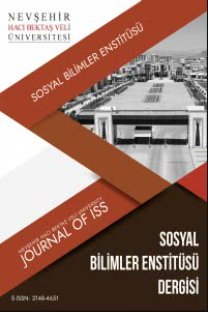İRAN’DA SİYASİ BİR SEMBOL OLARAK KADINLAR: PEHLEVİ REJİMİ İLE İSLAM DEVRİMİ ARASINDA KARŞILAŞTIRMALI BİR BAKIŞ
İran, Kadın Hakları, İslam Devrimi, Siyaset, Sembol
WOMEN AS A POLITICAL SYMBOL IN IRAN: A COMPARATIVE PERSPECTIVE BETWEEN PAHLAVI REGIME AND ISLAMIC REVOLUTION
Iran, Women Rights, Islamic Revolution, Politics, Symbol,
___
- Ahmadi-Khorasani, N. (2006). Women’s Letter: Iranian Women’s day of Solidarity. Tehran: Iranian Women’s Cultural Center.
- Afary, J. and K.B. Anderson (2005). Foucault and the Iranian Revolution: Gender and the Seductions of Islamism. Chicago: University of Chicago Press.
- Asghar, T. J.(2010). Good Hijabi, Bad Hijabi: The Politics of Women’s Clothing in Iran, Journal of Georgetown University-Qatar Middle Eastern Studies Student Association, 10.
- Bayat, A. (2007). Making Islam Democratic: Social Movements and the Post-Islamist Turn. Stanford, CA: Stanford University Press.
- Brooks, C. M. (2008). Moments of Strength: Iranian Women’s Rights and the 1979 Revolution, Honors Theses. Paper 292. Retrieved March 5, 2017, from https://digitalcommons.colby.edu/honorstheses/292
- De la Camara, A. (2012). Women's rights in Iran during the years of the shah, Ayatollah Khomeini, and Khamenei. HIM, 1990- 2015.1350, Retrieved February 15, 2017, from http://stars.library.ucf.edu/honorstheses1990-2015/1350.
- Deutchwelle (Persian) (2014). Chegoneh dar Avayele Enghelab Hijab Ejbari Shod, Retrieved February 12, 2017, from https://www.dw.com/fa-ir/.
- Esfandiari, H. (2001). The Politics of the ‘Women’s Question’ in the Islamic Republic, 1979-1999. In Iran at the Crossroads, J. L. Esposito & R.K. Ramazani (Eds). New York: Palgrave: 75-92.
- Faraji, M. (2014). Thirty-five years of forced hijab: the widespread and systematic violation of women’s rights in Iran, Justice for Iran.
- Farhi, F. (2001). On the Reconfiguration of the Public Sphere and the Changing Political Landscape of Post-revolutionary Iran. In Iran at the Crossroads, J. L. Esposito & R.K. Ramazani (Eds) New York: Palgrave: 57-74.
- Foucault. M. (1977). Discipline and Punish: The Birth of the Prison. Translated by Alan Sheridan, London: Allen Lane.
- Iran Human Rights Documentation Center, (2012). Islamic Penal Code of the Islamic Republic of Iran, Retrieved February 7, 2017, from https://www.icj.org/wp-content/uploads/2013/06/Iran-Islamic-Penal-Code-of-the-Islamic-Republic-of-Iran-1991-eng.pdf.
- ISNA, 2017. Daneshgahe Azad Yadegare Paydare Ayatollah Hashemi Rafsanjani. Retrieved, January 10, 2017, from isna.ir/news/95102113418/
- James, A.B. &Leiden, C. (1998). Politics in the Middle East. Boston and Toronto: Little, Brown Company.
- Justice for Iran (2014). Thirty-five Years of Forced Hijab: The Widespread and Systematic Violation of Women’s Rights in Iran.
- Keddie, N. R. (2007). Iranian Women’s Status and Struggles since 1979, Journal of International Affairs, 60 (2), 17-33.
- Kian, A. (1997). Women and Politics in Post-Islamist Iran: the Gender Conscious Drive to Change, British Journal of Middle Eastern Studies, 24 (1): 75-96.
- Koolaee, E. (2014). The Impact of Iraq-Iran War on Social Roles of Iranian Women, Middle East Critique, 23 (3): 277-291.
- Maloney, S. and Katz. E. (2019) Iran and the headscarf protests, Brookings, OP-ED, Retrieved February 15, 2019, from https://www.brookings.edu/opinions/iran-and-the-headscarf-protests/
- Middle East Online (2012) Sole woman in Iran cabinet sacked, Retrieved Febraury 10, 2019, https://middle-east-online.com/en/sole-woman-iran-cabinet-sacked
- Ministry of Interior. (2009). Gozareshe Entekhabat Majlis-e Shoraye Eslami (Majlis Election Report).
- Moghadam, V. M. (2004). Women in the Islamic Republic of Iran: Legal Status, Social Positions, and Collective Action. Washington D.C.: The Woodrow Wilson International Center for Scholars.
- Moinifar, H.S. (2011). Participation of Women in Iran’s Polity, Essay, GEMC Journal, 3 (2): 24-35.
- Nafisi, A. (2008). Reading Lolita. New York: Random House
- Najmabadi, A. (1991). Hazards of Modernity and Morality: Women, State and Ideology in Contemporary Iran, In Women, State, and Ideology, D. Kandiyotti (Ed), Philadelphia: Temple University Press: 48-77.
- Paidar, P. (2001). Gender of Democracy: The Encounter between Feminism and Reformism in Contemporary Iran. Geneva, DGHR Paper 6.
- Povey T. and E.R. Povey (2012). Women and Politics in the 21st Century Iran, New York: Routledge.
- Povey, E. R. and M. Poya (1999). Women, Work and Islamism: Ideology and Resistance: Ideology and Resistance in Iran. New York: Zed Books.
- Goli R.R.M. (2015). The politics of gender segregation and women's access to higher education in the Islamic Republic of Iran: the interplay of repression and resistance, Gender and Education, 27 (5): 469-486.
- Sadeghi, F. (2009). The foot soldiers of the Islamic Republic’s ‘‘Culture of Modesty’’, Middle East Report, 250,: 50–55.
- Sahimi, M. (2010).Iranian Women and the Struggle for Democracy, Frontline, Retrieved February 20, 2017, from https://www.pbs.org/wgbh/pages/frontline/tehranbureau/2010/04/iranian-women-and-the-struggle-for-democracy-i-the-pre-revolution-era.html.
- Shahidian, H. (1994). The Iranian Left and the ‘Women Question’ in the Revolution of 1978-79, International Journal of Middle East Studies, 26 (2): 223-247.
- Shavarini, M. (2005). Feminisation of Iranian Higher Education, Review of Education, 51(3): 29–347.
- Tahiyate. (2014). Nagheshe Zanan dar Piroozi Enghelabe Islami va Nehzate Imam Khomeini. (In Persian).
- The Guardian (2009). Iran appoints first female cabinet minister for 30 years, Retrieved Febraury 10, 2019, https://www.theguardian.com/world/2009/sep/03/iran-woman-cabinet-minister.
- Winn, M. K. (2016). "Women in Higher Education in Iran: How the Islamic Revolution Contributed to an Increase in Female Enrollment, Global Tides, 10 (10)
- Yayın Aralığı: 4
- Başlangıç: 2011
- Yayıncı: Nevşehir Hacı Bektaş Veli Üniversitesi
Emine ATALAY, Emine GÜNDOĞMUŞ, Birsen YENER AYDIN
CİNSİYET EŞİTLİĞİ KÜLTÜRÜYLE FEMVERTISING AKIMININ DEĞERLENDİRİLMESİ
Erdoğan KOÇ, Cansu TOR-KADIOĞLU
TÜRK ATASÖZLERINDE SOY VE AKRABALIK
MİR CAFER BAĞIROV ÖRNEĞİNDE SOVYETLER BİRLİĞİ’NİN İKİNCİ DÜNYA SAVAŞI İRAN POLİTİKASI
Kenan DEMİREL, İbrahim Ethem ATNUR
TÜRKİYE’DE BİRLEŞTİRİLMİŞ SINIF KONUSUNDA YAPILAN LİSANSÜSTÜ TEZLERİN İNCELENMESİ
DOĞU TÜRKİSTAN’DA ÇİN MODELİ EĞİTİM SİSTEMİ
HAVA YOLU TAŞIMACILIĞI YOLCU SAYISINI ETKİLEYEN FAKTÖRLER
TÜRK SİVİL HAVACILIK SEKTÖRÜNÜN EKONOMİK BÜYÜME ÜZERİNDEKİ ETKİSİ
ARAP BAHARI SONRASI DÖNEMDE BÖLGESEL GÜVENLİK KOMPLEKSİ BAĞLAMINDA İRAN’IN LÜBNAN SİYASETİ
